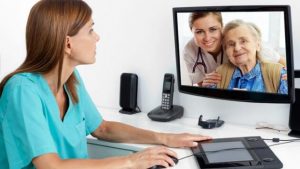
Healthcare might be a phone call or click away and it’s a 30 billion dollar market that continues to grow. From the common cold, to a stroke with seconds between life and death – Telemedicine is helping to diagnose and treat patients around the globe virtually.
The American Medical Association says nearly 75 percent of all doctor, urgent care and emergency room visits could be handled safely and effectively over the phone or through a video.
The American Medical Association says nearly 75 percent of all doctor, urgent care and emergency room visits could be handled safely and effectively over the phone or through a video.
Around seven million people around the world use telehealth services according to E-Visit and one study says 82 percent of millennials would rather have a telemedicine visit than an in-person consult.
Insurance companies are also listening. Forty-eight states are now requiring telehealth coverage in insurance plans and more than half of all hospitals are in the process of setting up a telehealth program, according to the American Telemedicine Association.
So how could telemedicine change the way we live and heal in the next decade?
“As far as a stroke is concerned…. Time is brain,” said emergency medicine doctor, Frank Biondolillo.
Every second counts when it comes to dealing with a stroke and the emergency department at Doctor’s Hospital in Sarasota is speeding up the care it provides to patients using new technology.
“Every minute that that care is delayed, that patient is losing 2 million brain cells every minute. That’s huge,” he said.
Having specialists right at the doctor’s fingertips can be the difference between life and death.
“When we have someone who may be having a stroke we have a neurologist at arm’s length in the emergency department through the camera.”
Dr. Biondolillo will see the patient, make sure vital signs are stable and rule out immediate life threats.
Then he said, “We pick up the phone, we call, the neurologist comes through the computer and their evaluating the patient immediately.”
Stroke Neurologist Amanda Avila lives in Fort Myers but works with a team of telespecialists that live around the country standing by to provide immediate care through a video conference call.
“We can make a diagnosis of stroke – and if appropriate we can treat them very quickly,” said Avila.
By reducing response time this technology is helping to make strides in patient care to provide a better chance at recovery.
“The faster a patient gets treated, the better his or her outcome,” Avila said.
Telemedicine is expanding rapidly, providing services to rural parts of the country that may not have access to specialty or even primary care.
Avila said, “What it’s done is expand the number of patients that have access to healthcare in a dramatic way.”
As the medical community aims to provide better patient care in the next decade – don’t be surprised if you see more of the 21st century’s version of a doctor’s house call.
“From psychiatry to perhaps doing medical evaluation screenings for patients when we have influxes of patients, that we can see out front to get things rolling,” said Biondolillo. “Yes I see this as a fertile field to grow.”
“Like the majority of people now purchase things online, we think the majority of people in 10 years are going to have some experience with telemedicine,” said Avila.
Plans are already in the works to implement the telemedicine program for psychiatry in the emergency room at Doctor’s Hospital.
(Reprinted -2020 WWSB 2-13-20)